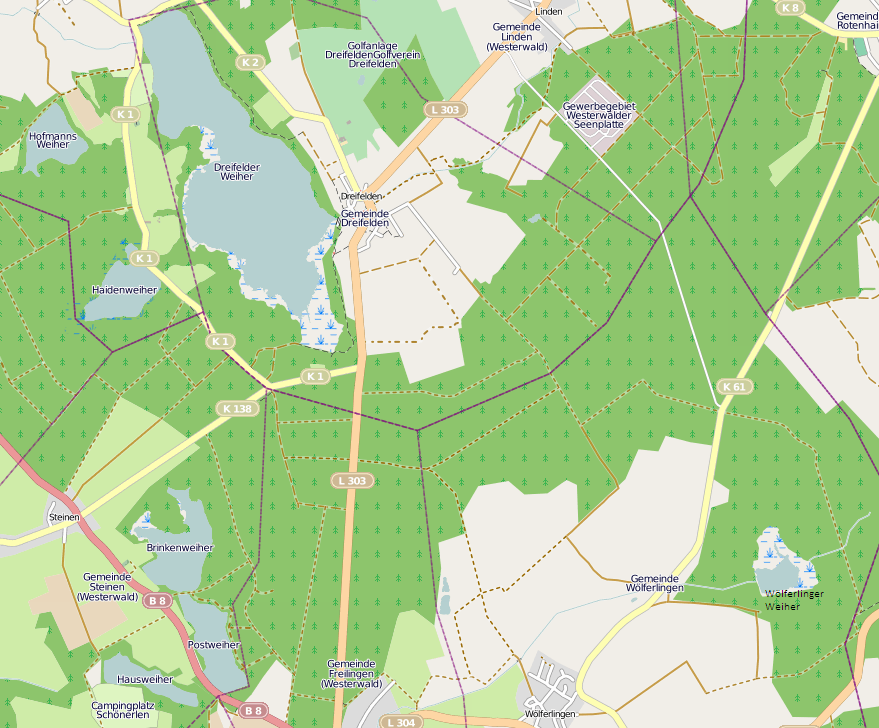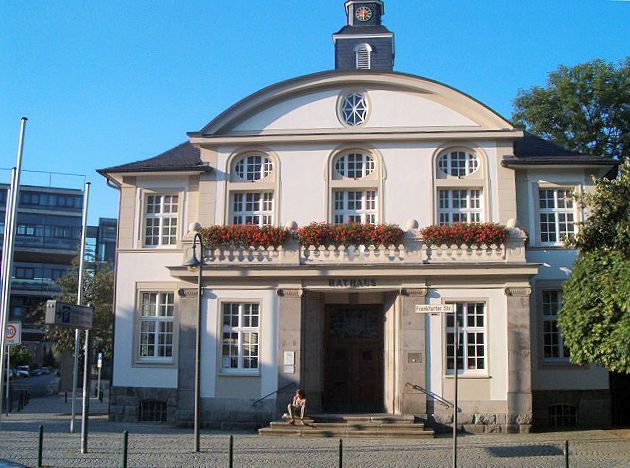|
Dreifelden
Dreifelden is an ''Ortsgemeinde'' – a community belonging to a ''Verbandsgemeinde'' – in the Westerwaldkreis in Rhineland-Palatinate, Germany. The name translates literally to English as "three fields". Geography On the southern boundary of the ''Verbandsgemeinde'' of Hachenburg – a kind of collective municipality – in the northwest Westerwaldkreis lies Dreifelden, on the biggest lake found on the Westerwald Lake District (''Westerwälder Seenplatte''), the Dreifelder Weiher. The ''Verbandsgemeinde'' to which the community belongs has its seat in the eponymous town. History Dreifelden was first recorded in 1319. In the centre of the village stands Holy Trinity Church (''Dreifaltigkeitskirche''), the oldest stone church in the Westerwald. Its origins go back to the Romanesque era around 1000 A.D. Until the Reformation it was used as pilgrimage church. Politics The municipal council comprises 9 council members, including the extra-official mayor (''Bürgermeister''), ... [...More Info...] [...Related Items...] OR: [Wikipedia] [Google] [Baidu] |
Westerwald Lake District
The Westerwald Lakes (german: Westerwälder Seen) lie within the eponymous Westerwald Lake District (''Westerwälder Seenplatte'') in the Westerwald forest within the town quarters of Hachenburg, Westerburg, Montabaur and Dierdorf in the German state of Rhineland-Palatinate. The lakes consist of seven ponds: * Brinkenweiher * Haidenweiher * Hausweiher * Hoffmannsweiher * Postweiher * Dreifelder Weiher (also Seeweiher) * Wölferlinger Weiher At 123 hectares, the Dreifelder Weiher is the largest. References External links Westerwald Lakes Development Association (''Entwicklungsverband Westerwälder Seenplatte'') Protected landscapes in Germany Lakes of Rhineland-Palatinate ! Rhineland {{RhinelandPalatinate-geo-stub ... [...More Info...] [...Related Items...] OR: [Wikipedia] [Google] [Baidu] |
Hachenburg (Verbandsgemeinde)
Hachenburg is a ''Verbandsgemeinde'' ("collective municipality") in the district Westerwaldkreis, in Rhineland-Palatinate, Germany. The seat of the ''Verbandsgemeinde'' is in Hachenburg. The ''Verbandsgemeinde'' Hachenburg consists of the following ''Ortsgemeinden'' ("local municipalities"): {{Authority control Verbandsgemeinde in Rhineland-Palatinate ... [...More Info...] [...Related Items...] OR: [Wikipedia] [Google] [Baidu] |
Westerwaldkreis
The Westerwaldkreis ("District of Westerwald") is a district (''Kreis'') in the north-east of Rhineland-Palatinate, Germany. Neighbouring districts are (from north clockwise) Altenkirchen, Lahn-Dill, Limburg-Weilburg, Rhein-Lahn, the district-free city Koblenz, Mayen-Koblenz and Neuwied. History When the area became part of Prussia in 1866 two districts covering the area were created. The northern part was covered by the Oberwesterwaldkreis with capital in Marienberg, the Unterwesterwaldkreis with capital in Montabaur covering the southern part. 1886 a third district was added with the Westerburg district with area from both of the other two districts. In 1932 the districts structure was reformed again, the Oberwesterwaldkreis and the Westerburg district were merged to a new Oberwesterwaldkreis with capital in Westerburg. In 1974 in another reform the districts Oberwesterwaldkreis and Unterwesterwaldkreis were merged to form the Westerwaldkreis. Together with the neighboring Rhein- ... [...More Info...] [...Related Items...] OR: [Wikipedia] [Google] [Baidu] |
Verbandsgemeinde
A Verbandsgemeinde (; plural Verbandsgemeinden) is a low-level administrative unit in the German federal states of Rhineland-Palatinate and Saxony-Anhalt. A Verbandsgemeinde is typically composed of a small group of villages or towns. Rhineland-Palatinate The state of Rhineland-Palatinate is divided into 163 Verbandsgemeinden, which are municipal associations grouped within the 24 districts of the state and subdivided into 2,257 Ortsgemeinden (singular Ortsgemeinde) which comprise single settlements. Most of the Verbandsgemeinden were established in 1969. Formerly the name for an administrative unit was ''Amt''. Most of the functions of municipal government for several municipalities are consolidated and administered centrally from a larger or more central town or municipality among the group, while the individual municipalities (Ortsgemeinden) still maintain a limited degree of local autonomy. Saxony-Anhalt The 11 districts of Saxony-Anhalt are divided into ''Verwaltungsgemein ... [...More Info...] [...Related Items...] OR: [Wikipedia] [Google] [Baidu] |
Autobahn
The (; German plural ) is the federal controlled-access highway system in Germany. The official German term is (abbreviated ''BAB''), which translates as 'federal motorway'. The literal meaning of the word is 'Federal Auto(mobile) Track'. German are widely known for having no federally mandated general speed limit for some classes of vehicles. However, limits are posted and enforced in areas that are urbanised, substandard, accident-prone, or under construction. On speed-unrestricted stretches, an advisory speed limit () of applies. While driving faster is not illegal as such in the absence of a speed limit, it can cause an increased liability in the case of a collision (which mandatory auto insurance has to cover); courts have ruled that an "ideal driver" who is exempt from absolute liability for "inevitable" tort under the law would not exceed . A 2017 report by the Federal Road Research Institute reported that in 2015, 70.4% of the Autobahn network had only the advis ... [...More Info...] [...Related Items...] OR: [Wikipedia] [Google] [Baidu] |
Bundesautobahn 5
is a 445 km (277 mi) long Autobahn in Germany. Its northern end is the Hattenbach triangle intersection (with the A 7. The southern end is at the Swiss border near Basel. It runs through the German states of Hessen and Baden-Württemberg and connects on its southern ending to the Swiss A 2. The A5 passes by the Frankfurt Airport. History Nazi era Construction for the first section, between Frankfurt and Darmstadt was started on 23 September 1933 by Adolf Hitler. Propaganda falsely celebrated the project as "the Führer's Autobahn" and "Germany's first Autobahn," but the AVUS race track in Berlin was opened in September 1921. The first public Autobahn was the Cologne-Bonn highway which was inaugurated August 1932 (later called A 555). It was downgraded to a state highway (German: Bundesstrasse) in order to let the Nazi propaganda proclaim that the Reichsautobahn Frankfurt-Darmstadt was the first ever built in Germany. Rare sight in Europe: 4 lanes in ... [...More Info...] [...Related Items...] OR: [Wikipedia] [Google] [Baidu] |
Hennef
Hennef (Sieg) () is a town in the Rhein-Sieg district of North Rhine-Westphalia, Germany. It is situated on the river Sieg, approx. south-east of Siegburg and east of Bonn. Hennef is the fourth-biggest town in the Rhein-Sieg-Kreis (i.e. district). It is the site of the 15th-century castle, Schloss Allner, next to the Allner See. Within Hennef is the town of Stadt Blankenberg, with the castle of Blankenberg. Hennef is also known as the "City of 100 villages". Twin towns – sister cities Hennef is twinned with: * Banbury, England, United Kingdom (1981) * Le Pecq, France (1997) * Nowy Dwór Gdański, Poland (2001) Trivia * The first calibratable automatic weighing scales in the world were invented by Carl Reuther in Hennef * Hennef's current district of Geistingen was first mentioned in a document from 885. Hennef itself was first mentioned in 1075 as "Hannafo" * The national football team sometimes trains here; at the FIFA Confederations Cup in 2005 the Argentina national ... [...More Info...] [...Related Items...] OR: [Wikipedia] [Google] [Baidu] |
Bundesautobahn 3
is an autobahn in Germany running from the Germany-Netherlands border near Wesel in the northwest to the Germany-Austria border near Passau. Major cities along its total length of 778 km (483 mi) include Oberhausen, Duisburg, Düsseldorf, Leverkusen, Cologne, Wiesbaden, Frankfurt, Würzburg, Nuremberg and Regensburg. The A 3 is a major connection between the Rhine-Ruhr area and southern Germany, resulting in heavy traffic. Consequently, large parts have three lanes (plus a hard shoulder) in each direction, including a 300 km (187.5 mi) section between Oberhausen and Aschaffenburg. The A3 passes by the Frankfurt Airport. Overview The A 3 begins at the border crossing Elten in North Rhine-Westphalia as a four-lane continuation of the Dutch A 12. Until Oberhausen the highway runs on the right bank of the Lower Rhine past the cities Emmerich, Wesel and Dinslaken and reaches the Ruhrgebiet. Beginning at the ''Kreuz Oberhausen'' with A 516 and A 2, the A ... [...More Info...] [...Related Items...] OR: [Wikipedia] [Google] [Baidu] |
Dierdorf
Dierdorf is a town in the district of Neuwied, in Rhineland-Palatinate, Germany. It is situated in the Westerwald, approx. 20 km northeast of Neuwied, and 20 km north of Koblenz. Dierdorf is the seat of the ''Verbandsgemeinde'' ("collective municipality") Dierdorf. Local council The elections in May 2014 showed the following results. Sister city Dierdorf is the sister city of Fountain Hills (USA), Courtisols (France) and Krotoszyn (Poland). Sons and daughters of the town * Eva Grebel Eva K. Grebel is a German astronomer. Since 2007 she has been co-director of the Astronomisches Rechen-Institut at the University of Heidelberg in Germany. Eva Grebel is an expert in the study of stellar populations and galaxy formation. Resea ... (born 1966), astronomer, professor at the Center for Astronomy at the University of Heidelberg * Juan Holgado (born 1968), Spanish archer (Olympic champion 1992) * Samir El-Assal (born 1966), C.E.O of Frank GmbH References ... [...More Info...] [...Related Items...] OR: [Wikipedia] [Google] [Baidu] |
Mogendorf
Mogendorf is a municipality in Westerwaldkreis district, Rhineland-Palatinate, in western Germany Germany,, officially the Federal Republic of Germany, is a country in Central Europe. It is the second most populous country in Europe after Russia, and the most populous member state of the European Union. Germany is situated betwee .... References Municipalities in Rhineland-Palatinate Westerwaldkreis {{Westerwaldkreis-geo-stub ... [...More Info...] [...Related Items...] OR: [Wikipedia] [Google] [Baidu] |
Interchange (road)
In the field of road transport, an interchange (American English) or a grade-separated junction (British English) is a road junction that uses grade separations to allow for the movement of traffic between two or more roadways or highways, using a system of interconnecting roadways to permit traffic on at least one of the routes to pass through the junction without interruption from crossing traffic streams. It differs from a standard intersection, where roads cross at grade. Interchanges are almost always used when at least one road is a controlled-access highway (freeway or motorway) or a limited-access divided highway (expressway), though they are sometimes used at junctions between surface streets. Terminology ''Note:'' The descriptions of interchanges apply to countries where vehicles drive on the right side of the road. For left-side driving, the layout of junctions is mirrored. Both North American (NA) and British (UK) terminology is included. ; Freeway juncti ... [...More Info...] [...Related Items...] OR: [Wikipedia] [Google] [Baidu] |
Bundesstraße
''Bundesstraße'' (German for "federal highway"), abbreviated ''B'', is the denotation for German and Austrian national highways. Germany Germany's ''Bundesstraßen'' network has a total length of about 40,000 km. German ''Bundesstraßen'' are labelled with rectangular yellow signs with black numerals, as opposed to the white-on-blue markers of the ''Autobahn'' controlled-access highways. ''Bundesstraßen'', like autobahns, are maintained by the federal agency of the Transport Ministry. In the German highway system they rank below autobahns, but above the ''Landesstraßen'' and ''Kreisstraßen'' maintained by the federal states and the districts respectively. The numbering was implemented by law in 1932 and has overall been retained up to today, except for those roads located in the former eastern territories of Germany. One distinguishing characteristic between German ''Bundesstraßen'' and ''Autobahnen'' is that there usually is a general 100 km/h (62 mph) s ... [...More Info...] [...Related Items...] OR: [Wikipedia] [Google] [Baidu] |





